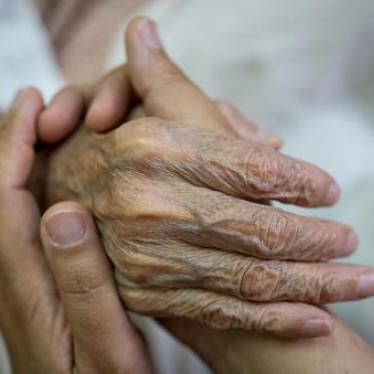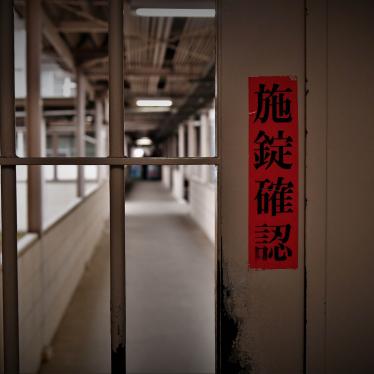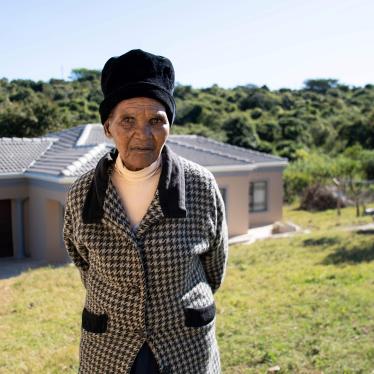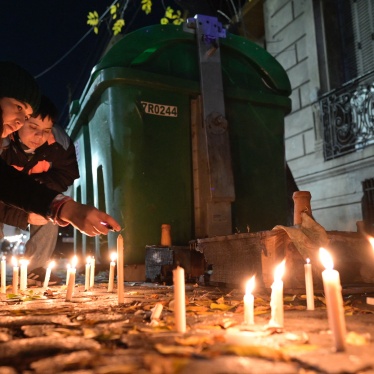There are inherent risks in the institutionalization of older people. More protections from those risks are needed, particularly around decision-making. A “best interests” standard for decision making “for your own good” is not good enough. Older people’s rights in long-term care must be underpinned by support to make decisions about their own lives.
“Joe”
When I first met “Joe” during a research trip in the US, he was sitting on the edge of his bed, tall and fit-looking. He had a view over the tops of the suburban Chicago homes surrounding the nursing facility where he was living. He was in his mid-sixties, recently retired. He was in a locked unit. Unlike some other residents there, Joe still wore his own clothes.
We talked in the common area on the unit, a room with a blaring TV, some tables and chairs, and residents slumped and sleeping. He quietly told me how a month or so before, he had felt like he was having a heart attack in his Chicago apartment. He had put on his jacket to leave for the emergency room, locked his front door, and pressed the button for the elevator. Then he blacked out. His neighbors found him and called an ambulance. He spent a week in the hospital for recovery from the heart attack and a concussion from falling when he blacked out. And then, to his surprise, the hospital arranged to send him to the nursing facility where we met. He did not understand why.
Blinking in disbelief in the winter afternoon sunlight, he told me that he had been there for weeks. He had repeatedly asked the medical staff there why he was there; he did not know of any support needs he had. He told me that staff had told him they were going to create a plan of care for him. According to him, more than three weeks into his stay, he still did not have one. (I did not ask the facility myself because he told me he was cautious about pressing for more information because he did not want to appear distrustful of the medical and administrative staff at the facility. He was afraid that could have negative repercussions.)
But he was increasingly anxious to go home, or at least to know when he would be able to. His rent was due and he was worried he might lose his apartment. Though he didn’t seem to have any disabilities, I gave him the number for a charity that specializes in helping to advocate for people with disabilities to move from institutions into the community. I also gave him my phone number, and asked him to call me if he couldn’t get the help he needed. I didn’t hear from him again.
Joe had a lot of things going for him. He had an easy way about him and communicated so that I could easily understand him. He had family and friends. He had a cellphone. He lived in an urban area with a dedicated charity that might be able to help him. Even with these advantages, institutional life left him feeling dependent and afraid.
The heightened risks of institutionalisation
Dependency on an institution brings with it inherent risks, whether that institution is a prison, an orphanage, a psychiatric institution, or a nursing facility. Joe’s story illustrates a few of the inherent risks to human rights associated with being an older person living in an institution. First, he depended on that facility for permitting physical access to the outside world. He said that he wanted to go home, but could not. He was living in isolation, away from the community. His said that his wishes were not acknowledged or acted upon, even when he raised them repeatedly. Second, he depended on that facility to give him a bed to sleep on, food to eat, and any medicines he required. This control made him hesitant to ask even basic questions about why he was there. He was to some degree locked in and out of the view of society. If the facility failed to deliver what he needed, Joe could face risks to his health, his family life, and more.
The risks to rights associated with institutionalisation are increasingly recognized. In 1999, the Supreme Court of the United States wrote a famous decision in Olmstead v LC. In it, the Court required the least restrictive alternative setting for people with disabilities to receive care. It recognized the inherent risks of living in a restrictive environment: “Recognition that unjustified institutional isolation of persons with disabilities is a form of discrimination reflects… [an evident judgement that] confinement in an institution severely diminishes the everyday life activities of individuals . . ..”
For many older people in nursing facilities, the most serious risks stem from a fundamental problem: the de facto elimination of their right to make decisions. In Joe’s case, this meant that there were no procedural safeguards to support his wishes to go back home.
“For your own good”
Standard practice for the formal elimination of decision-making rights has historically allowed a substitute decision-maker to make decisions on behalf of another person. In some places, this is called guardianship. Usually, such a substitute decision-maker is required to use a “best interests” standard, essentially the same framework commonly used for decisions made about and on behalf of children. The substitute decision-maker decides what is best for the person, rather than supporting the person’s will and preferences in a taking a decision. The risks to older people’s rights in the formal guardianship system in the US are well documented. Australian advocates have also pointed out an “ad hoc” system of guardianship that can leave older people stripped, for all practical purposes, of their decision-making capacity and therefore create vulnerability to abuse.
Currently, over half of residents in US nursing facilities have some level of dementia and may require decision-making support. Globally, an increasing number of countries have accepted that guardianship and other substitute decision making regimes should be abolished. Under the United Nations Convention on the Rights of Persons with Disabilities, all people with disabilities (this includes those disabilities prevalent among persons in nursing facilities) are entitled to freely make their own choices. Almost all countries have signed the Convention or have become parties to it. Australia ratified the Convention in 2008; the US has signed but not yet ratified the treaty. Under the Convention’s framework, people with disabilities –including older people living with dementia-- should receive the support they need to exercise this right to make their own choices, including with regard to choices about medicines, treatments, visitors, and financial matters. Dementia is not an all-or-nothing condition. The US Department of Health and Human Services’ Administration for Community Living has funded research on best practices in supported decision-making to better understand how to implement this new standard, but there has been little academic research on nursing facility resident decision-making.
In the environment of a nursing facility, where nearly every aspect of a person’s existence can be controlled, a facility often does not even need to go through the formalities of guardianship to achieve the same de facto result. This is a big loophole, one that could affect a huge proportion of Americans if left unchecked: 56 percent of Americans now in their late fifties are projected to use a nursing facility at some point.
Better legal protections
Once the inherent risks of institutionalisation are understood, the question becomes what to do about them. Laws to protect people living in such settings against some of the most important risks are relatively recent. National laws regulating nursing facilities in the United States were introduced only in 1987. A report by Human Rights Watch in 2018 on abuses against older people in nursing homes in the US notes that “It is essential that [decision making] planning starts at the point of admission to the facility.” These processes should be explicit, and should be designed to support the will and preferences of older people throughout their stay at a facility. Older people living in nursing facilities depend on strong legal protections and enforcement to maintain their safety and dignity in a context where the motivations of facilities’ costs, risks, and complexities of care can work against the individuals living in them.
Older nursing facility residents can only realize their rights with an agreed process for supporting their decision making. If older people choose to live in a nursing facility, law and regulations should ensure that their rights are upheld.









